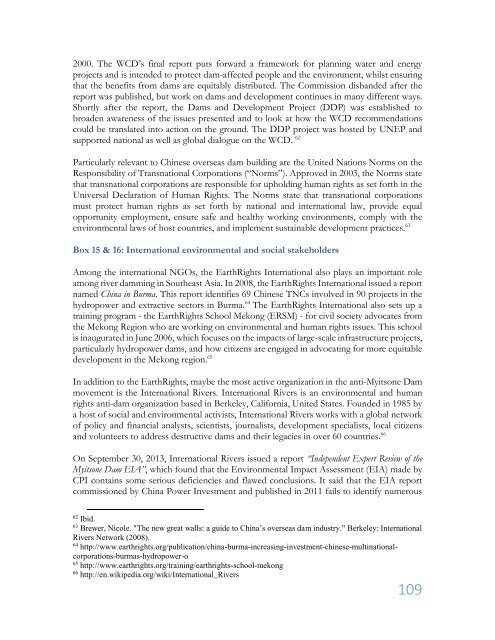Yale-WWF_final
Yale-WWF_final
Yale-WWF_final
You also want an ePaper? Increase the reach of your titles
YUMPU automatically turns print PDFs into web optimized ePapers that Google loves.
2000. The WCD’s <strong>final</strong> report puts forward a framework for planning water and energyprojects and is intended to protect dam-affected people and the environment, whilst ensuringthat the benefits from dams are equitably distributed. The Commission disbanded after thereport was published, but work on dams and development continues in many different ways.Shortly after the report, the Dams and Development Project (DDP) was established tobroaden awareness of the issues presented and to look at how the WCD recommendationscould be translated into action on the ground. The DDP project was hosted by UNEP andsupported national as well as global dialogue on the WCD. 62Particularly relevant to Chinese overseas dam building are the United Nations Norms on theResponsibility of Transnational Corporations (“Norms”). Approved in 2003, the Norms statethat transnational corporations are responsible for upholding human rights as set forth in theUniversal Declaration of Human Rights. The Norms state that transnational corporationsmust protect human rights as set forth by national and international law, provide equalopportunity employment, ensure safe and healthy working environments, comply with theenvironmental laws of host countries, and implement sustainable development practices. 63Box 15 & 16: International environmental and social stakeholdersAmong the international NGOs, the EarthRights International also plays an important roleamong river damming in Southeast Asia. In 2008, the EarthRights International issued a reportnamed China in Burma. This report identifies 69 Chinese TNCs involved in 90 projects in thehydropower and extractive sectors in Burma. 64 The EarthRights International also sets up atraining program - the EarthRights School Mekong (ERSM) - for civil society advocates fromthe Mekong Region who are working on environmental and human rights issues. This schoolis inaugurated in June 2006, which focuses on the impacts of large-scale infrastructure projects,particularly hydropower dams, and how citizens are engaged in advocating for more equitabledevelopment in the Mekong region. 65In addition to the EarthRights, maybe the most active organization in the anti-Myitsone Dammovement is the International Rivers. International Rivers is an environmental and humanrights anti-dam organization based in Berkeley, California, United States. Founded in 1985 bya host of social and environmental activists, International Rivers works with a global networkof policy and financial analysts, scientists, journalists, development specialists, local citizensand volunteers to address destructive dams and their legacies in over 60 countries. 66On September 30, 2013, International Rivers issued a report “Independent Expert Review of theMyitsone Dam EIA”, which found that the Environmental Impact Assessment (EIA) made byCPI contains some serious deficiencies and flawed conclusions. It said that the EIA reportcommissioned by China Power Investment and published in 2011 fails to identify numerous62Ibid.63Brewer, Nicole. "The new great walls: a guide to China’s overseas dam industry." Berkeley: InternationalRivers Network (2008).64http://www.earthrights.org/publication/china-burma-increasing-investment-chinese-multinationalcorporations-burmas-hydropower-o65http://www.earthrights.org/training/earthrights-school-mekong66http://en.wikipedia.org/wiki/International_Rivers109


